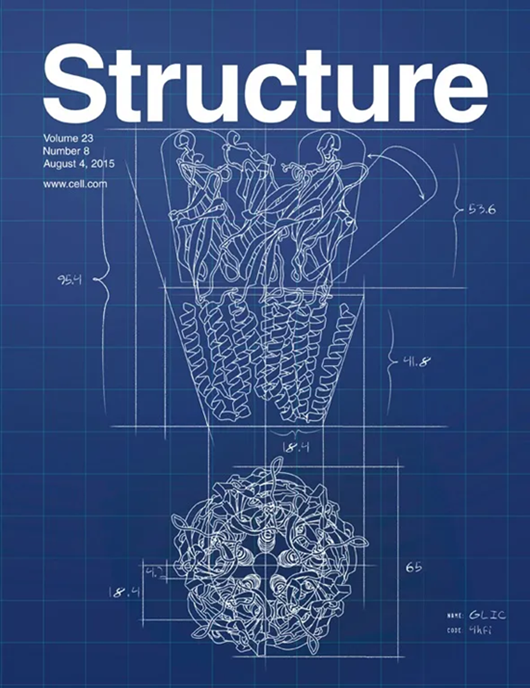Structural basis for no retinal binding in flotillin-associated rhodopsins
IF 4.3
2区 生物学
Q2 BIOCHEMISTRY & MOLECULAR BIOLOGY
引用次数: 0
Abstract
Rhodopsins are light-sensitive membrane proteins capturing solar energy via a retinal cofactor covalently attached to a lysine residue. Several groups of rhodopsins lack the conserved lysine and showed no retinal binding. Recently, flotillin-associated rhodopsins (FArhodopsins or FARs) were identified and suggested to lack the retinal-binding pocket despite preserving the lysine residue in many members of the group. Here, we present cryoelectron microscopic (cryo-EM) structures of paralog FArhodopsin and proteorhodopsin from marine bacterium Pseudothioglobus, both forming pentamers similar to those of other microbial rhodopsins. We demonstrate no binding of retinal to the FArhodopsin despite preservation of the lysine residue and overall similarity of the protein fold and internal organization to those of the retinal-binding paralog. Mutational analysis confirmed that two amino acids, H84 and E120, prevent retinal binding within the FArhodopsin. Our work provides insights into the natural retinal loss in microbial rhodopsins and might contribute to the further understanding of FArhodopsins.

游离蛋白相关视紫红质无视网膜结合的结构基础
视紫红质是一种光敏膜蛋白,通过与赖氨酸残基共价连接的视网膜辅助因子捕获太阳能。几组视紫红质缺乏保守的赖氨酸,没有显示视网膜结合。最近,flotillin-associated rhodopsin (farhodopsin或FARs)被发现,尽管在该组的许多成员中保留赖氨酸残基,但缺乏视网膜结合袋。在这里,我们展示了来自海洋细菌Pseudothioglobus的类似FArhodopsin和proteorhodopsin的冷冻电镜(cryo-EM)结构,两者都形成与其他微生物紫红质相似的五聚体。我们证明视网膜与FArhodopsin没有结合,尽管保留了赖氨酸残基,并且蛋白质折叠和内部组织与视网膜结合平行体的蛋白质折叠和内部组织总体相似。突变分析证实,两种氨基酸,H84和E120,在FArhodopsin内阻止视网膜结合。我们的工作提供了对微生物视紫红质自然视网膜损失的见解,并可能有助于进一步了解farhodopsin。
本文章由计算机程序翻译,如有差异,请以英文原文为准。
求助全文
约1分钟内获得全文
求助全文
来源期刊

Structure
生物-生化与分子生物学
CiteScore
8.90
自引率
1.80%
发文量
155
审稿时长
3-8 weeks
期刊介绍:
Structure aims to publish papers of exceptional interest in the field of structural biology. The journal strives to be essential reading for structural biologists, as well as biologists and biochemists that are interested in macromolecular structure and function. Structure strongly encourages the submission of manuscripts that present structural and molecular insights into biological function and mechanism. Other reports that address fundamental questions in structural biology, such as structure-based examinations of protein evolution, folding, and/or design, will also be considered. We will consider the application of any method, experimental or computational, at high or low resolution, to conduct structural investigations, as long as the method is appropriate for the biological, functional, and mechanistic question(s) being addressed. Likewise, reports describing single-molecule analysis of biological mechanisms are welcome.
In general, the editors encourage submission of experimental structural studies that are enriched by an analysis of structure-activity relationships and will not consider studies that solely report structural information unless the structure or analysis is of exceptional and broad interest. Studies reporting only homology models, de novo models, or molecular dynamics simulations are also discouraged unless the models are informed by or validated by novel experimental data; rationalization of a large body of existing experimental evidence and making testable predictions based on a model or simulation is often not considered sufficient.
 求助内容:
求助内容: 应助结果提醒方式:
应助结果提醒方式:


